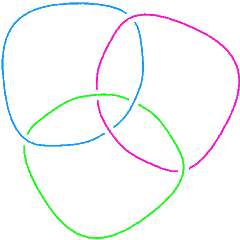Gauss Codes
From Knot Atlas
Jump to navigationJump to search
The Gauss Code of an -crossing knot or link is obtained as follows:
- Number the crossings of from 1 to in an arbitrary manner.
- Order the components of is some arbitrary manner.
- Start "walking" along the first component of , taking note of the numbers of the crossings you've gone through. If in a given crossing you cross on the "over" strand, write down the number of that crossing. If you cross on the "under" strand, write down the negative of the number of that crossing.
- Do the same for all other components of (if any).
The resulting list of signed integers (in the case of a knot) or list of lists of signed integers (in the case of a link) is called the Gauss Code of . KnotTheory` has some rudimentary support for Gauss codes:
(For In[1] see Setup)
| ||||
Thus for example, the Gauss codes for the trefoil knot and the Borromean link are:
In[2]:=
|
GaussCode /@ {Knot[3, 1], Link[6, Alternating, 4]}
|
Out[2]=
|
{GaussCode[-1, 3, -2, 1, -3, 2],
GaussCode[{1, -6, 5, -3}, {4, -1, 2, -5}, {6, -4, 3, -2}]}
|
 3_1 |
 L6a4 |
Ralph Furmaniak, working under the guidance of Stuart Rankin and Ortho Flint at the University of Western Ontario, wrote a web-based server called "Knotilus" that takes Gauss codes and outputs pictures of the desired knots and links in several standard image formats.
| ||||
Thus,
In[4]:=
|
KnotilusURL /@ {Knot[3, 1], Link[6, Alternating, 4]}
|
Out[4]=
|
{http://srankin.math.uwo.ca/cgi-bin/retrieve.cgi/-1,3,-2,1,-3,2/goTop.h\
tml, http://srankin.math.uwo.ca/cgi-bin/retrieve.cgi/1,-6,5,-3:4,-1,\
2,-5:6,-4,3,-2/goTop.html}
|

